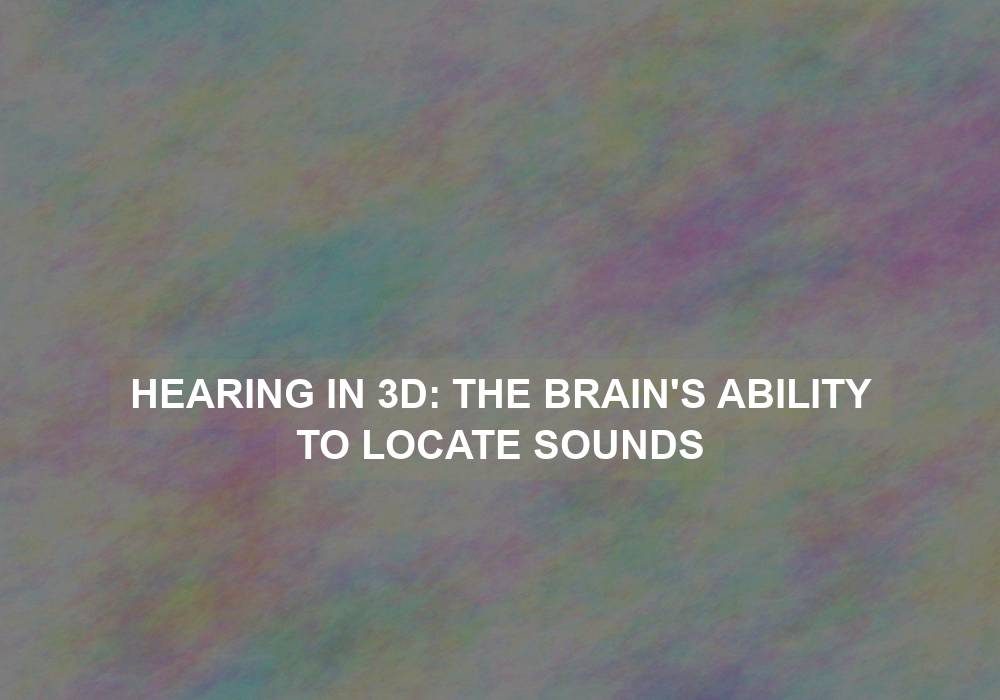The human auditory system is a remarkable mechanism that allows us to perceive and locate sounds in our environment. Our brain’s ability to process sound information and accurately determine the source of a sound is crucial for our everyday functioning. In this article, we will explore the fascinating concept of hearing in 3D and delve into the intricate processes involved in the brain’s ability to locate sounds.
Understanding Sound Localization
Sound localization refers to the brain’s ability to determine the origin or location of a sound source in space. This ability is essential for our survival and plays a significant role in various aspects of our lives, such as avoiding danger, locating objects, and engaging in social interactions.
To understand how sound localization works, let’s consider a scenario. Imagine you’re walking in a park, and suddenly, you hear a bird chirping. Without even consciously thinking about it, your brain processes the sound and instantly tells you the direction from which the sound is coming. This ability is made possible through a complex interplay of processes involving our ears and the brain.
The Role of the Auditory System
The auditory system consists of the ears, auditory nerves, and various brain regions responsible for processing sound information. It is a highly specialized system that allows us to perceive and interpret sounds in our environment.
Outer Ear
The outer ear, consisting of the pinna (the visible part of the ear) and the ear canal, plays an important role in capturing and directing sound waves towards the middle ear. The shape and structure of the pinna help in localizing sounds based on the subtle differences in sound arrival time and intensity between the two ears.
Middle Ear
The middle ear, comprising the eardrum and three tiny bones (ossicles), is responsible for transmitting sound waves from the outer ear to the inner ear. The ossicles, consisting of the malleus, incus, and stapes, amplify the sound vibrations and ensure efficient transmission.
Inner Ear
The inner ear, also known as the cochlea, is where the magic happens. It converts sound waves into electrical signals that can be interpreted by the brain. The cochlea consists of thousands of tiny hair cells that are sensitive to different frequencies of sound. These hair cells generate electrical impulses in response to sound vibrations, which are then transmitted to the brain via the auditory nerves.
Binaural Hearing: The Key to Sound Localization
One of the crucial factors enabling sound localization is our ability to perceive sound using both ears, known as binaural hearing. By comparing the differences in sound arrival time and intensity between the two ears, our brain can determine the location of a sound source accurately.
Interaural Time Difference (ITD)
When a sound source is off to one side, it reaches the ear closest to it slightly earlier than the other ear. This slight time difference, known as the interaural time difference (ITD), provides important cues for sound localization. The brain analyzes these time differences to determine the horizontal position of a sound source.
Interaural Level Difference (ILD)
In addition to time differences, the brain also relies on differences in sound intensity, known as interaural level differences (ILD), between the two ears. When a sound source is closer to one ear, that ear receives a slightly louder sound compared to the other ear. These differences help the brain determine the vertical position of a sound source.
Neural Processing and Sound Localization
Once the sound signals from both ears reach the brain, they undergo complex neural processing to determine the precise location of the sound source. Several brain regions are involved in this process, including the superior olive, inferior colliculus, and auditory cortex.
Superior Olive
The superior olive is a brainstem structure that acts as a central hub for integrating sound information from both ears. It receives inputs from various brainstem nuclei and performs intricate computations to analyze the interaural time and level differences. This information is then forwarded to higher auditory centers for further processing.
Inferior Colliculus
The inferior colliculus, located in the midbrain, plays a crucial role in sound localization. It receives input from the superior olive and other auditory structures, further refining the auditory information. The neurons in the inferior colliculus are highly selective to specific sound localization cues, aiding in the accurate determination of sound source location.
Auditory Cortex
The auditory cortex, located in the temporal lobe of the brain, receives processed sound information from the inferior colliculus. It is responsible for the conscious perception of sound and plays a vital role in analyzing complex auditory stimuli. The auditory cortex integrates information from both ears and combines it with other sensory inputs to provide a comprehensive perception of sound location.
Factors Affecting Sound Localization
While the human auditory system is highly efficient in localizing sounds, certain factors can influence the accuracy of sound localization.
Environmental Factors
The environment in which sound is produced can impact localization. Factors such as background noise, reverberation, and sound reflection can introduce additional cues or distortions, making it challenging for the brain to accurately determine the sound source’s location.
Hearing Impairment
Individuals with hearing impairments may experience difficulties in sound localization. Reduced hearing sensitivity or hearing loss in one or both ears can affect the brain’s ability to process the necessary cues for accurate sound localization.
Learning and Experience
Our ability to localize sounds may also be influenced by learning and experience. Studies have shown that individuals can improve their sound localization skills with training, suggesting that our brain’s plasticity and adaptability play a role in refining this ability.
In conclusion, our brain’s ability to locate sounds in 3D is a remarkable feat of neural processing and sensory integration. By leveraging interaural time and level differences, our auditory system allows us to accurately determine the location of sound sources in our environment. Understanding the intricacies of sound localization enhances our appreciation for the complexity and sophistication of the human auditory system.
